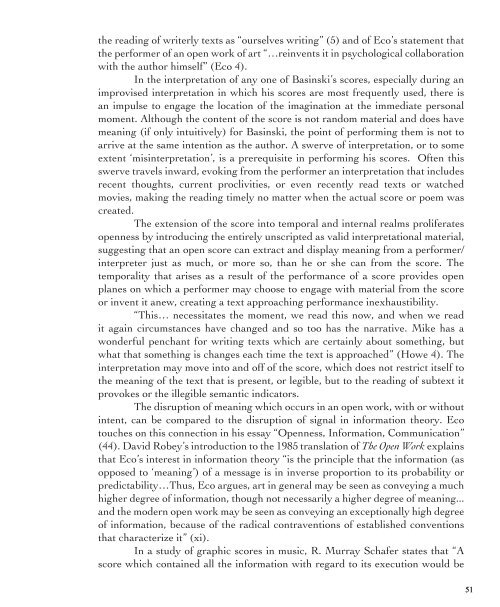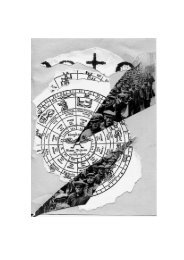P L A N T A R C H Y 2 - Critical Documents
P L A N T A R C H Y 2 - Critical Documents
P L A N T A R C H Y 2 - Critical Documents
Create successful ePaper yourself
Turn your PDF publications into a flip-book with our unique Google optimized e-Paper software.
the reading of writerly texts as “ourselves writing” (5) and of Eco’s statement that<br />
the performer of an open work of art “…reinvents it in psychological collaboration<br />
with the author himself” (Eco 4).<br />
In the interpretation of any one of Basinski’s scores, especially during an<br />
improvised interpretation in which his scores are most frequently used, there is<br />
an impulse to engage the location of the imagination at the immediate personal<br />
moment. Although the content of the score is not random material and does have<br />
meaning (if only intuitively) for Basinski, the point of performing them is not to<br />
arrive at the same intention as the author. A swerve of interpretation, or to some<br />
extent ‘misinterpretation’, is a prerequisite in performing his scores. Often this<br />
swerve travels inward, evoking from the performer an interpretation that includes<br />
recent thoughts, current proclivities, or even recently read texts or watched<br />
movies, making the reading timely no matter when the actual score or poem was<br />
created.<br />
The extension of the score into temporal and internal realms proliferates<br />
openness by introducing the entirely unscripted as valid interpretational material,<br />
suggesting that an open score can extract and display meaning from a performer/<br />
interpreter just as much, or more so, than he or she can from the score. The<br />
temporality that arises as a result of the performance of a score provides open<br />
planes on which a performer may choose to engage with material from the score<br />
or invent it anew, creating a text approaching performance inexhaustibility.<br />
“This… necessitates the moment, we read this now, and when we read<br />
it again circumstances have changed and so too has the narrative. Mike has a<br />
wonderful penchant for writing texts which are certainly about something, but<br />
what that something is changes each time the text is approached” (Howe 4). The<br />
interpretation may move into and off of the score, which does not restrict itself to<br />
the meaning of the text that is present, or legible, but to the reading of subtext it<br />
provokes or the illegible semantic indicators.<br />
The disruption of meaning which occurs in an open work, with or without<br />
intent, can be compared to the disruption of signal in information theory. Eco<br />
touches on this connection in his essay “Openness, Information, Communication”<br />
(44). David Robey’s introduction to the 1985 translation of The Open Work explains<br />
that Eco’s interest in information theory “is the principle that the information (as<br />
opposed to ‘meaning’) of a message is in inverse proportion to its probability or<br />
predictability…Thus, Eco argues, art in general may be seen as conveying a much<br />
higher degree of information, though not necessarily a higher degree of meaning...<br />
and the modern open work may be seen as conveying an exceptionally high degree<br />
of information, because of the radical contraventions of established conventions<br />
that characterize it” (xi).<br />
In a study of graphic scores in music, R. Murray Schafer states that “A<br />
score which contained all the information with regard to its execution would be<br />
51





